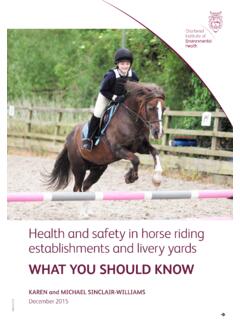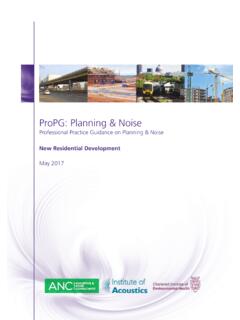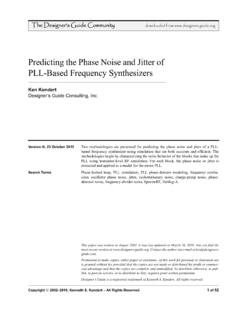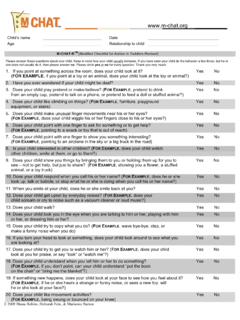Transcription of under Part 4 of the Anti-social Behaviour, Crime and …
1 Professional Practice Note1 Guidance on the use of community Protection Notices under Part 4 of the Anti-social Behaviour, Crime and policing Act 2014 Part 4 of the Anti-social Behaviour, Crime and policing Act 20142 came into effect in England and Wales on 20 October 2014. This was accompanied by government guidance on the use of measures to control Anti-social behaviour (ASB). Statutory Guidance for Frontline Professionals was issued by the Home Office in July 20143 and government guidance on specific matters associated with ASB has been published on animals4 and Japanese Knotweed5. The Act aims to fill the gaps left in earlier legislation, consolidate enforcement powers and simplify the tools available to counter Anti-social behaviour: aims which the CIEH fully supports.
2 But difficult issues are raised as to when long established powers under previous legislation should be used instead of or in addition to the new powers. The potential for confusion particularly applies with regard to the relationship between the 2014 Act and the statutory nuisance provisions of the Environmental Protection Act 1990. The Statutory Guidance published by the Home Office provides little assistance, leaving the prospect of confusion, duplication and wasted effort by different agencies. At the same time, in the CIEH s view, the Statutory Guidance understates the complexities of applying the new community Protection measures.
3 It has little to say about which circumstances require expert assessment6 or when other established controls7 should be used in preference to the new powers. This Professional Practice Note is intended to help clarify the use of community Protection notices and to encourage local authorities to develop policies giving effect to the 2014 Act. This requires negotiating with other relevant agencies and agreeing on how to use the new powers consistently, fairly and effectively. It should be borne in mind that the new powers are permissive so there is not a statutory duty to investigate or inspect, as there is for statutory nuisances under Part 3 of the Environmental Protection Act 1990.
4 1 This Professional Practice Note has been extensively revised in response to expert advice provided by John Pointing, Barrister and David Horrocks, Independent Chartered EHP of Statutory Nuisance Solutions. 2 At 3 Anti-social Behaviour, Crime and policing Act 2014, Reform of Anti-social behaviour powers: statutory guidance for frontline professionals, Home Office, July 2014 at: Although not obligatory this Statutory Guidance does have weight and agencies should have regard to it. 4 Dealing with irresponsible dog ownership, Practitioner s Manual, Defra, October 2014. 5 Reform of Anti-social behaviour powers: Japanese Knotweed and other invasive non-native plants, Home Office, Note, 2014.
5 6 For example, acoustic assessment. 7 For example under the Environmental Protection Act 1990, the noise Act 2006, the Clean Air Act 1993, the Licensing Act 2003, the Clean Neighbourhoods and Environment Act 2005 or the Town and Country Planning Act 1990. 2 Guidance on the use of community Protection Notices At a glance community Protection Notices are intended to stop a natural person or a body (eg a legal person such as a business) continuing with conduct which unacceptably affects victims and the community . They can be issued by authorised council officers, police officers, police community support officers (PCSOs) if designated by a chief officer of police, and social landlords if designated by the council, in circumstances where there are reasonable grounds to believe the subject s conduct: is having a detrimental effect on the quality of life of those in the locality, and is unreasonable, and the behaviour is of a persistent or continuing nature.
6 Before a community Protection Notice can be issued, the subject must be given a written warning stating that a community Protection Notice will be issued unless their conduct ceases to have the detrimental effect. Failure to heed a warning after sufficient time and where that effect continues, may then lead to the issue of a community Protection Notice requiring them: to stop doing specified things and/or to do specified things and/or to take reasonable steps to achieve a specified result where those requirements are reasonable and have the aim of either preventing the effect of the conduct, or reducing it, or reducing or preventing the likelihood of it continuing or recurring.
7 Where the recipient fails to comply with a community Protection Notice, the local authority may have work carried out to ensure that the failure is remedied. The costs of work being undertaken in default by the council can be challenged on the ground that they are excessive. A failure to comply with a community Protection Notice without reasonable excuse is a summary offence carrying a maximum penalty on conviction of a fine of up to level 4 for individuals, or an unlimited fine in the case of a business or other body. Alternatively, an Authorised Person may issue a Fixed Penalty Notice (max 100) conferring immunity from prosecution for that offence if paid within 14 days.
8 Items used in the commission of an offence on any premises may be seized under a Warrant and may, following conviction, be ordered to be handed-over for destruction or disposal in another way. A right of appeal against a community Protection Notice or its terms lies to a Magistrates Court within 21 days of issue. Guidance on the use of community Protection Notices 3 1 Introduction The Anti-social Behaviour, Crime and policing Act 2014 received royal assent on 13 March 2014. The Act introduces a number of powers intended to enable the police, local authorities and social landlords to deal more effectively with Anti-social behaviour.
9 Chapter 1 of Part 4 contains the provisions relating to community Protection Notices and was brought into effect by SI 2014/2590, on 20 October 2014. It extends only to England and Wales. community Protection Notices (CPNs) were introduced to deal with a wide range of Anti-social behaviours impacting on victims and communities. Indeed, their scope is deliberately not limited in the legislation to specific situations or types of behaviour. Lord Taylor stated during the Bill stage that the government s intention was to fill the gaps left by previous measures, adding: (To say) it can be used for this behaviour but not that behaviour would simply return us to mistakes from the past.
10 We must move on from focusing on the behaviour, and instead understand the impact it is having on the victims and communities that are being damaged 8. community Protection Notices issued under of the Act9 are intended to deal with repeated or on-going conduct - not occasional or `one-off` conduct. It also needs to be shown that such conduct - of individuals aged over 16 or bodies - negatively and unacceptably affects the quality of life of those in the locality10. 8 Lords Hansard, 20 Nov 2013, Col 1048. 9 References to primary legislation are to the Anti-social Behaviour, Crime and policing Act 2014 unless otherwise stated.








